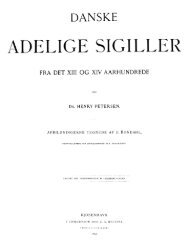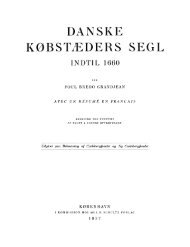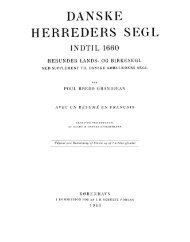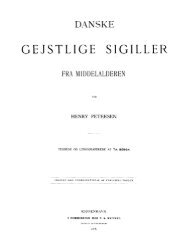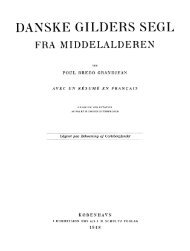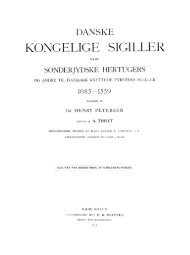Oldtidsagre - Genstandskundskab
Oldtidsagre - Genstandskundskab
Oldtidsagre - Genstandskundskab
You also want an ePaper? Increase the reach of your titles
YUMPU automatically turns print PDFs into web optimized ePapers that Google loves.
160 Nr. 1<br />
upon more fertile and heavy clayey soils. Unfortunately, we have no remnants<br />
of “<strong>Oldtidsagre</strong>" upon moraine-clay. Two localities in Sealand, No. 117, Topshøj<br />
forest, and No. 118, Geel's hill, are placed upon morainic gravel. The last<br />
named locality contains some stone-heaps and some balks, which, however, are so<br />
slight that a mapping is difficult. In Topshøj forest, the traces of cultivation are more<br />
conspicuous, and a survey of them was undertaken. cf. p. 119 and Fig. 90. Stoneheaps<br />
and lynchets are found, somewhat similar to those in No. 95, Addit forest<br />
(cf. SEHESTED 188-1, pp. 117 seq.). However, the fields are more distinct in Addit<br />
forest, because there the fields are in most cases completely Surrounded by lynchets.<br />
In Topshøj forest, on the other hand, none of the fields are wholly Surrounded by<br />
lynchets; still, their shape may to some extent be discerned. In Topshøj as in Addit,<br />
the fields are broad, and their outlines are rather irregular.<br />
The reason why the Topshøj-fields are imperfectly outlined may be due to the<br />
fact that no drifting of dust or sand has taken place, as in the sandy regions of Jutland.<br />
One of the natural factors, furthering the development of high balks, is absent<br />
in Topshøj.<br />
Unfortunately, we do not know the age of the Topshøj locality, as no datable<br />
objects were found.<br />
The possibility that ridged strip-fields dominated in the more fertile parts of<br />
Denmark, already during Early Iron Age, has been discussed above (p. 156).<br />
The locality No. 119, Blemme Lyng, Bornholm, has not been visited by me;<br />
PETER THoRsEN has described it, however. The fields are more or less rectangular<br />
and broad, the areas varying between 190 >< 50 m and 70 >< 40 m. THoRsEN has dated<br />
them to Late Bronze Age, some of the fields having been used for burial-places in<br />
the transition-period between the Bronze Age and the Iron Age. The Bornholm fields<br />
differ somewhat from the ancient fields in Jutland; the balks are low walls, not made<br />
of earth, but consisting of stones collected from the fields. This reminds of Iron Age<br />
enclosures in Oland and Gotland.<br />
VII. Ancient fields outside Denmark.<br />
Scandinavia. Associated with numerous remnants of Iron Age houses in the<br />
Swedish islands of Oland and Gotland, enclosures are found, Surrounded by low<br />
stone-walls. Some of these enclosures are interpreted as cattle-pens and sheep-folds,<br />
others as enclosed pastures. Some of the enclosures may have been cultivated, although<br />
agriculture was less important than cattle-raising. The cultivated plots were<br />
apparently often placed at some distance from the farm-buildings (STENBERGER<br />
1933, p. l06). In Gotland, however, cultivated fields were also found quite close to<br />
the farm-houses (NIHLÉN och Boiârmus 1933, p. 215).<br />
In Östergötland, on the Swedish mainland. the so-called “stensträngar" are found.



